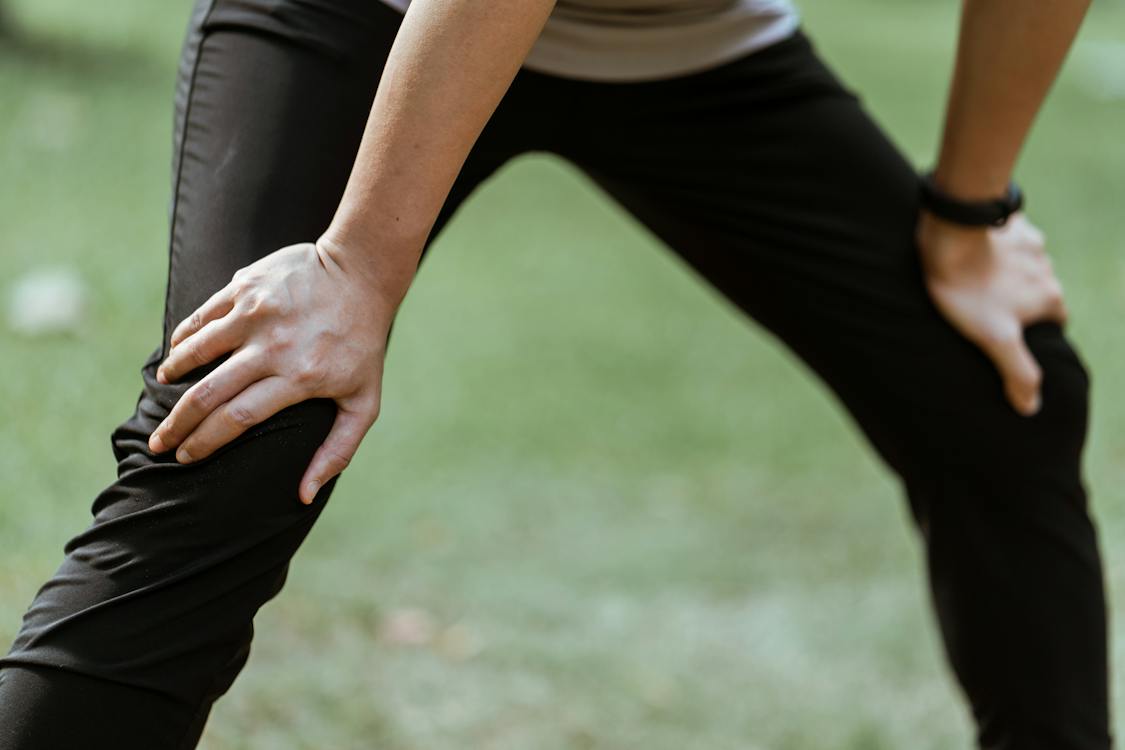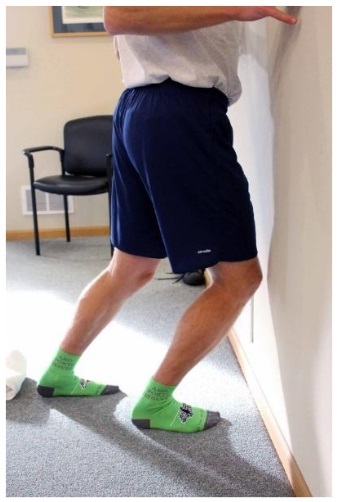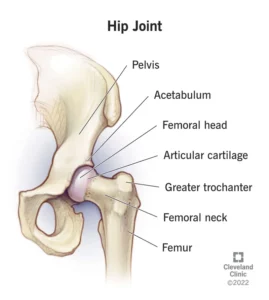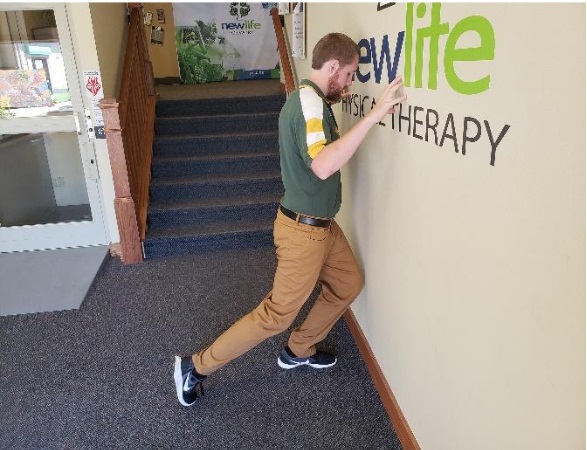On Wed, Aug 14, 2024 from 5:30pm - 6:30pm, we are hosting a FREE Hip Pain Workshop [ Online
] - Click here for more info
October 25, 2023

Knee pain is one of most injured or painful areas for people trying to live their best lives. Whether you are suffering from stiff/achy knees, or knees that cause sharp pain and you can’t trust to load and use for daily tasks, this can be a significant roadblock to doing what is important in life. Due to the knee being primarily a hinge joint (it does rotate a small amount and move side to side a small amount), it can commonly get stuck in the middle of our lower quarter with no where to go. Below we are going to briefly discuss important areas to focus on if you are struggling with knee pain in day-to-day life and some ideas on ways to improve your lower body function to your knee and keep it from crying out for help.
Just below the knee joint is the ever-important ankle joint, which we refer to as the talocrural joint. This is comprised of 3 bones: the tibia, fibula, and talus. This article from the Cleveland Clinic (https://my.clevelandclinic.org/health/body/24909-ankle-joint) highlights it well:

 The tibia and fibula form a mortise which is a concave surface which glides and moves over a convex surface, the talus. One very important movement for this joint to perform is referred to as ankle dorsiflexion or bending of our ankle. When this joint is stiff and unable to bend, it can lead to increased stress up the chain to the rest of the body, and the next link in the chain is of course the knee. With poor ankle dorsiflexion, it makes it difficult to squat, lunge, get on/off the ground, walk with normal mechanics, and go up and down stairs.
The tibia and fibula form a mortise which is a concave surface which glides and moves over a convex surface, the talus. One very important movement for this joint to perform is referred to as ankle dorsiflexion or bending of our ankle. When this joint is stiff and unable to bend, it can lead to increased stress up the chain to the rest of the body, and the next link in the chain is of course the knee. With poor ankle dorsiflexion, it makes it difficult to squat, lunge, get on/off the ground, walk with normal mechanics, and go up and down stairs.
A simple test we like to perform to check the mobility of the ankle is a knee to wall test. Simply stand at a wall with one foot in front of the other and your toes up against the wall. Keeping your heel on the ground, move your knee towards the wall and touch the wall. This should be very easy to do. However, this is not adequate mobility, and you should gradually work your toes back from the wall about 1 inch at a time and see how far away you can get from the wall and still reach your knee to touch the wall without your heel rising from the ground. We like to see a minimal amount of your own hand width from the wall, more mobility is even better. If you cannot get this distance, you may experience a pinching in the front of the ankle or a stretch in the back of the ankle/calf. If there is pinching, it might be a good idea to have a physical therapist assess this. If it is a stretch, you can start working on this by working that motion back and forth while you feel this stretch and work on gradually improving this motion. Your knees will thank you for it later!
While we discussed the major joint just below the knee, it would make sense to look just above the knee at the hip. The hip is a ball and socket joint comprised of our femur and our ischium (or pelvis). Cleveland Clinic also has a great photo and article that describes the hip joint, found here: https://my.clevelandclinic.org/health/body/24675-hip-joint

 This large and mobile structure can be thought of as a major conductor in helping the knee properly function as the femur (thigh bone) makes up our hip and our knee. We often say, “where the hip goes the knee will follow.” We want to look at all planes of movement of the hip in regard to knee pain, but one key plane is our transverse plane (rotation). We typically like to see around 90deg of total rotation ability of our hip which is usually split between internal and external rotation (45deg of each). If our hip is stiff and does not rotate well, the knee is asked to rotate more during daily tasks, a movement it is not designed to do.
This large and mobile structure can be thought of as a major conductor in helping the knee properly function as the femur (thigh bone) makes up our hip and our knee. We often say, “where the hip goes the knee will follow.” We want to look at all planes of movement of the hip in regard to knee pain, but one key plane is our transverse plane (rotation). We typically like to see around 90deg of total rotation ability of our hip which is usually split between internal and external rotation (45deg of each). If our hip is stiff and does not rotate well, the knee is asked to rotate more during daily tasks, a movement it is not designed to do.
A simple movement we like to do to warm up and loosen up the hip is standing in a slightly staggered stance with slight bend in the knees to load the legs and then gently turn the pelvis (belt line) in both directions. You are trying to get your pelvis to twist and turn around your fixed femur or thigh bone. This can be a great way to prepare the body for twisting tasks and allow for the large muscles in our hip (glutes) to be able to turn on and help with our daily movements to help the knee function optimally.
Finally, we need to look at the strength or ability for the knee joint to accept load/force/weight through it. A common myth is that allowing your knee to go over your toes is “bad for the knee.” This is a complete myth and is in fact an important position for the knee to be able to tolerate in terms of having strength and stability. Think of going down a stair. There is no way for you to descend a stair without allowing your knee to go over your toes. Or perhaps squatting low or getting on/off the ground. Our knee needs to be able to handle the stress of that movement.
One way to check and then work on progressing this ability is to go back to the knee to wall test discussed in the first part of this article. Once you have adequate ankle mobility with that test, now see if you can put all the weight of your body on one foot and guide your knee to the wall.

If this causes pain or you feel weak, this is an exercise you can gradually progress to build your strength and load tolerance of your knee. You may have to start off with a 50/50 split of your weight on the front foot and then gradually increase the amount of weight on that front foot as pain/discomfort allows. We always allow for slight discomfort during the exercise that goes away after you stop. Start with a tolerable amount of weight on your leg and do this frequently until that does not cause any pain, then advance the amount of weight. Continue this until you can stand with 100% of your weight on that foot and bring your knee to the wall without discomfort.
Again, the knee can be a difficult area for many of us that can limit our ability to do the important things in life. To help improve your knee health and ability to function make sure you have adequate ankle dorsiflexion (bending), have mobile hips (especially ability to rotate), and have good strength or load tolerance of the knee joint. If you can do these things and progressively challenge them over time, you should start to see a major difference in your daily knee pain. If you are unable to improve things on your own, don’t hesitate to get some help from a movement professional such as a physical therapist. You may just need some guidance to ensure you are doing what your body needs. Cheers to happy/healthy knees!